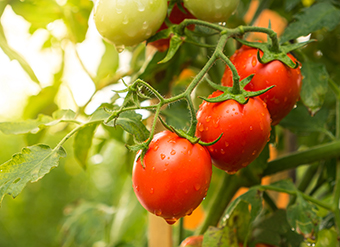Tips on Caring for Perennials in Winter

The Perennial Farm uses white plastic to cover cold houses because it helps keep the temperature consistent inside the house. Photo: The Perennial Farm
As a grower of landscape-sized perennials, ornamental grasses, hardy ferns, groundcover, flowering shrubs, vines, and more, The Perennial Farm is well-versed in growing a wide variety of perennials year-round. Based in Glen Arm, MD, for more than 40 years, we are equally familiar with growing in all types of climates and weather, including overwintering our perennials, which allows many of our varieties to mature enough and develop a strong root system by the spring season.
For us, the overwintering process begins in mid-October when we start to move our plant material around the nursery into the areas where it will remain throughout the cold winter months. These areas are typically outside container areas, inside covered cold houses, and inside covered heated houses.
It is around this same time that we also begin to trade in our greenhouse shade cloth coverings for white plastic. We choose white plastic to cover these cold houses because it helps keep the temperature consistent inside the house. Perennials that stay evergreen, semi-evergreen, or perennials with a fleshy-enough root system need to overwinter in a cold house, as opposed to a heated house or outdoors. This also frees up room for plants being potted during winter.
Once the plastic is set and plants have migrated around the nursery, all plants are weeded and cut back as their foliage dies off. We do not cut back evergreen or semi-evergreen plants all the way. Instead, we trim them no more than a third; these evergreen perennials need some foliage in order to survive the cold weather.
Next, we drench and spray plants for diseases before finally, as temperatures cool (around Christmas for us here in Maryland; we are Zone 6), we cover all plants in outdoor container areas with winter blankets made of 8-ounce needle-punch fiber. These blankets help keep plant roots from freezing and thawing repeatedly as the temperature rises and falls during the over-wintering month. Additionally, we monitor the temperature underneath all blankets throughout the winter season.
At The Perennial Farm, we use anywhere from one to two layers of blankets depending on the variety of plant and the outside weather. We do this for all perennials overwintering outside except sedums and festucas, which in our experience tend to do better uncovered. Our beds are then consolidated and arranged for ease of inventory and blanketing, and poison blocks are spread throughout to help deter vermin like mice and voles. Lastly, maps of each bed are catalogued so early spring orders are easier to pull.
The process of overwintering perennials, or any plant for that matter, is an ever-changing progression that should be watched closely throughout each winter season. We’ve honed our process over the past 41 years and continue to adjust not only each winter season, but each month within that season as the weather changes, snow falls, and temperatures fluctuate.
Three Overwintering Rules to Follow
- Start early enough to leave time to properly prepare for the winter. For example, you should wait until non-evergreen perennials’ tops have completely died off before cutting them back to over-winter.
- Wait as late into the season as possible to cover plants with blankets, but make sure they are covered prior to the first snow. Similarly, uncover the blankets as early into the spring as possible, depending on the weather.
- Be sure to check periodically, and consistently, the temperatures underneath each blanket and inside each cold house.









